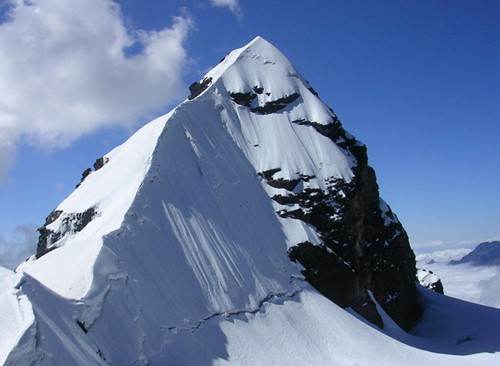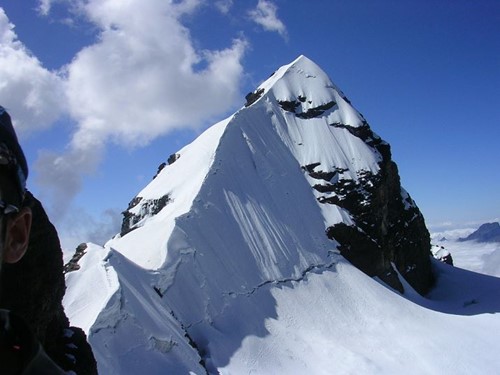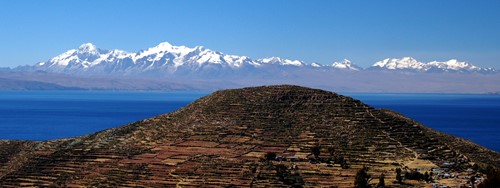| Quick Links | ||||||
|---|---|---|---|---|---|---|
| Trips | Where Are The Andes? |
Guided Tours in Bolivia |
Guided Treks |
Requirements | Preparation | Why Climb the Andes |
Aconcagua Climbing Trips
These are guided mountain expeditions and we offer both the Horcones route and the Vacas Valley route. We normally run one or two trips per year. Mount Aconcagua summit at 6962m high is the highest mountain in the Western hemisphere and the highest mountain in the world outside the Himalayas, located in western Argentina near the Chile border. It is one of the fabled Seven Summits, the highest peaks on each of the seven continents.
There are about 3500 climbers trying the summit each season. The normal routes are non-technical with sections of snow and ice, both following the Northwest Ridge to the summit from the same final camp. Despite its lack of technical challenge, there is still a bit of preparation for Aconcagua, Aconcagua summit. The altitude and the weather and the high level of self-sufficiency required pose the biggest challenges, so this is not a climb for the uninitiated.
This expedition is more physically and mentally demanding than mountains like Mount Elbrus or Mount Kilimanjaro, requiring a good working knowledge of camping, cooking and cold weather survival skills. Fitness is important too; there are Aconcagua porters available, but there is more self-carrying of loads up to around 15 kilos at altitude. The trip is expedition style and the route involves a 3 or 4-day walk-in to base camp followed by two or three high camps before the Aconcagua summit day. We recommend a good period of preparation for Aconcagua and we will help with as much advice as possible.
This is a great expedition for aspiring mountaineers looking to really stretch themselves and tackle some higher altitudes. The mountain itself is challenging and should not be underestimated but with sufficient preparation and training will be a significant achievement to stand on the highest point of South America. It can be dangerous but there is a procedure for rescues off the mountain and the Rangers are very helpful, plus there is a helicopter service that will take people down to the gate.
Mount Aconcagua has two summits, north and south, joined by a ridge called the Cresta del Guanaco which is nearly one kilometre long. Other ridges radiate from each Aconcagua summit, and the whole massif is isolated from other peaks. Shaped like a giant wedge, it has a very steep and massive face to the South and a gentler slope to the North. The huge Polish glacier flows to the East and a series of arêtes and couloirs flank it on the West. The view from the top and from the Cresta is particularly dramatic and well worth the effort of
Aconcagua tour facts
The teams are normally between 5 and 10 people, and we use our own guides to lead the trip along with local Argentinian guides. The guide to member ratio is never more than 1:5 for the walk in and the carrying to high camps and the summit day.
We do expect that our teams show involvement in the jobs of cooking and camping above base camp, so experience of camping and cooking in a tent is important. The success of the trip is partly in providing good personal preparation for every member, and developing the camaraderie and team effort that is the hallmark of any safe trip in the mountains.
The carries are done by the team, with everyone helping to move supplies to the high camps, but there are Aconcagua porters at base camp who can be hired; members can individually or as a team decide to hire porters for their own personal equipment. On average porters cost USD$250 per load carry of 20kgs, but this is dependent on the height/camp they are going to. The company will often assist with providing porters to carry group gear.
There is a clear policy of what do in the event of a rescue on Aconcagua, the national park rangers are very well versed in how to assist with a descent and there is a helicopter on standby to take people back to the park gate. However, there is a clear understanding that any team should be prepared to self-manage any emergency on the mountain rather than just rely on the ranger service.
Where are the Andes Mountains?
The Andes form the spine of the south American continent running 7000 kilometres with peaks in Ecuador, Chile, Colombia, Peru, Argentina, Bolivia & Venezuela. In fact, they are the longest mountain chain in the world.
The highest peak of all the climbs in the Andes and the highest in South America,and indeed the highest mountain in the world outside the Himalayas is Mount Aconcagua in Argentina. We offer guided climbs on both major routes of this peak, and the main season is from December to the end of February. We run one trip per year normally, taking it in turns on either the Horcones or the Vacas Valley side. Group sizes are normally about ten, and our trips use base camp services and mules as far as base camp, after which the teams are self-sufficient.
Mount Aconcagua, located in Argentina, is one of the Seven Summits and the highest peak in the Americas. Located in the Mendoza province of Argentina. The mountain itself has several glaciers, with the northern route providing the easiest way to the summit. Another option for climbing Aconcagua is via the Vacas Valley. This route traverses the Polish Glacier and joins the standard route towards the top. Many consider this peak to be non-technical because ropes and pins are not always required. However, don’t be fooled, climbing mount Aconcagua is tough business and it should not be taken lightly.
Experience Guided Treks and Climbs in Bolivia
Meanwhile the Cordillera Real in Bolivia are a great destination for the less experienced climber at high altitude looking for other peaks in the Andes. There are no peak fees or permits as in Nepal and the spectacular peaks are easily accessed from La Paz. We offer guided trips to Huayna Potosi and Pequeno Alpamayo in Bolivia. These fantastic mountains are located in the Southern Cordillera Real, near La Paz, making them some of the more accessible peaks in the range.
Guided trekking in Bolivia is a delight and it does feel like the convenience of the European Alps has met the grandeur of the more remote and higher Greater Ranges. The mountain range lies between the Altiplano plateau and the Amazon rainforest, the climate is generally stable and very pleasant and you can combine your trip with a visit to Lake Tititcaca.
Pequeno Alpamayo and Huayna Potosi are two of the popular peaks in this range, the standard routes are not highly technical but they are mountains of real character and quality. The season is from May to September when there is typically stable snow and minimal precipitation. We run trips to these peaks every year, providing qualified guided support and training for teams of up to twelve.

Experience Required to Go on a Guided Climb in the Andes
What these peaks lack in technical climbing knowledge, they make up for in elevation. You must be physically fit to embark on a climb in the Andes. This means that you should be able to carry heavy loads, endure rapidly changing weather, and be mentally and physically prepared. A good kit is essential. Preferably one you have extensive experience using. The key to a good kit starts with ensuring you have comfortable footwear. Be sure to spend many miles in your footwear, both mountaineering and trekking, prior to trekking in the Andes.

The summit ridge of Pequeno Alpamayo.
Each climb has a list of gear required for your expedition. Understanding how to use this gear and field testing it prior to bringing it on a climb in the Andes is extremely important. Understand how to fit your different parts of kit, such as your pack, sleeping bag, crampons, and shoes. Many gear shops have good return policies and most gear companies stand behind their products. Try these types of shops for peace of mind.
Prior to any climb in the Andes, it is important to know how both your body and mind react at altitude. Understanding if you have a tendency towards a cough, stomach ache, or head ache is very helpful in terms of your ability to recognize signs of altitude sickness. Our guided treks and climbs in the Andes focus on going slow and taking the proper time to acclimatize. If at any point you are not well or something does not feel right, don’t be ashamed, talk to your guide about your problem.
Preparation for an Andes Climbing Expedition
As mentioned before, Adventure Alternative aims to keep everyone in a climbing team properly acclimatized. We recommend staying properly hydrated. Drink significantly more than you need, especially in dry or cold conditions. A good rule of thumb is to drink double what you think you need, especially above 3,000m. Altitude tends to cause appetite suppression, so be sure to eat at every meal in order to replenish your energy level. Bring a tasty treat from home for a day when nothing looks good. This is not only a great way to give yourself some much-needed calories, but it’s a fun way to share something from your home country with other climbers on the mountain.
Lastly, climbing mountains is more than just a feat of physical strength, it requires mental endurance as well. The entire climb can seem insurmountable at first, so instead try to focus on one small part of the climb. You can choose to focus on the day's task, or even an interesting landmark a few minutes walk in front of you. Everything you climb up, you must also climb down, so be sure to understand your limits and abilities. Communicate your concerns with the team, they are there to support you just as much as you are there to support them. Maintain a positive attitude.

Cordillera Central Bolivia. Views to the peaks beyond.
Sleep can be hard to come by at altitude. To battle this and other altitude symptoms, we recommend you walk higher than you sleep that day. Once you have set up your camp go for a short walk to a point higher than the camp so you can acclimatize faster.
The Joys of Trekking and Climbing in the Andes
The Andes are a diverse place, stretching the length of the entire continent of South America. Each region has its own distinct climbing experience. Mount Aconcagua offers the opportunity to stand on the tallest point in the Americas. Pequeno Alpamayo and Huayna Potosi boast fantastic views and some of the best trekking in the Andes. Nevado Ojas del Salado in Chile provides an excellent opportunity to climb in a one-of-a-kind high alpine environment.

